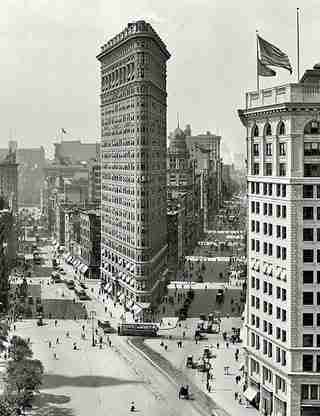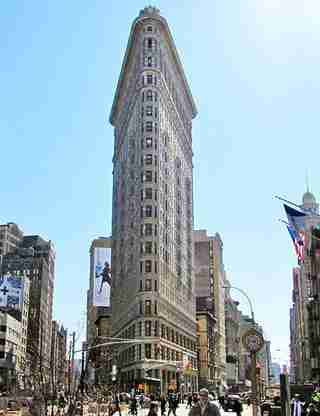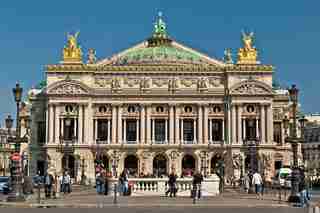Landmark Buildings Then & Now

Flatiron Building, New York, 1909
Completed in 1902, Daniel Burnham’s Beaux Arts Fuller Building—nicknamed "Flatiron" for its distinct shape—towered over neighboring buildings and avenues.

Flatiron Building, New York, 2010
Still a landmark and tourist destination in New York, today the Flatiron overlooks a bustling intersection and lush Madison Square Park.

Opéra Garnier, Paris, 2009
While cars and a Métro station have replaced horse-drawn carriages in front of its ornate façade, the Opéra National de Paris still plays host to operas, ballets, and recitals and was listed as a historical monument in 1923. In 1964 Marc Chagall covered the ceiling of the Opéra’s Italian Room with a now-iconic mural.
Opéra Garnier, Paris, late 19th century
At the time of its inauguration in 1875, Charles Garnier’s grand theater was the center of Parisian social life, a place for members of the upper class to see and be seen.
Louvre, Paris, 1899
Originally constructed as a fortress in 1190, the Louvre had changed royal hands many times over by the late 19th century. Under the direction of Louis Le Vau, most of the original medieval structure was demolished in the mid-1600s; the former residence was repurposed as a national museum, one of the first of its kind, by Louis XIV in the late 17th century.
Sagrada Familia, Barcelona, circa 1970
In 1882 Francisco de Paula del Villar began construction of the famous Barcelona cathedral. The following year Antoni Gaudí joined the project, giving the structure its unique, near-fantastical aesthetic. He worked on the cathedral until his death in 1926.
Sagrada Familia, Barcelona, 2009
Though dozens of architects have contributed to its construction since Gaudí’s death, the cathedral remains unfinished.
Louvre, Paris, 2014
Today reflecting pools surround I. M. Pei’s crystalline glass pyramids in the Cour Napoléon.
U.S. Capitol Building, Washington D.C., c. 1910
Constructed in the 1790s, the U.S. Capitol Building first opened to Congress in 1800. Architect William Thornton’s neoclassical design was partially inspired by the Louvre.
U.S. Capitol Building, Washington D.C., 2006
The Capitol, with its Frederick Law Olmsted–designed grounds and a 580,000-square-foot visitor center, is one of Washington’s most popular tourist destinations.
Ferry Building, San Francisco, 2008
The building was widely lauded for its sound structure, which has withstood strong earthquakes. Today it plays host to one of San Francisco’s largest indoor markets.
Ferry Building, San Francisco, circa 1900
After opening in 1898, San Francisco’s Ferry Building, designed by A. Page Brown, an alum of legendary American firm McKim, Mead, and White, became a portal for the city’s maritime trade.
Seagram Building, New York, 1956
Ludwig Mies van der Rohe’s midtown-Manhattan skyscraper was a feat of modernist design and engineering when it was completed in 1958. Architecture critic Herbert Muschamp called it "the millennium’s most important building," and it set an aesthetic tone for decades of urban architecture.
Seagram Building, New York, 2009
Over half a century later, the building’s iconic Four Seasons restaurant, designed by Philip Johnson, is still one of New York’s most distinguished eateries.
Basilica de San Marco, Venice, circa 1900
Venice’s first San Marco was built in A.D. 828. When a fire destroyed the structure in A.D. 976, it was almost completely rebuilt. Since then, the Byzantine-style basilica in Venice’s most famous square has been continually modified.
Basilica de San Marco, Venice, 2012
Rising waters in Venice often result in the flooding of the church’s piazza.
Kremlin, Terem Palace, Moscow, 19th century
The ornate Russian palace was built in 1636 and served as a residence for the country’s royal families. Russian artist Fedor Solntsev renovated the palace’s interiors in 1830.
Kremlin, Terem Palace, Moscow, 2003
As part of the Great Kremlin Palace complex, the structure remains closed to the public today.